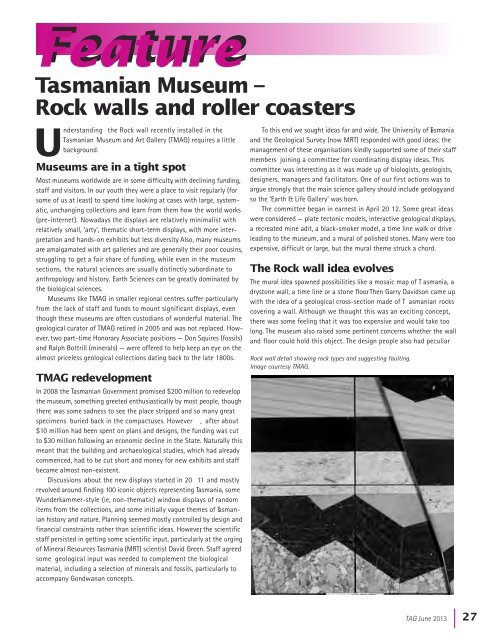TAG 167WEB
TAG 167WEB
TAG 167WEB
Create successful ePaper yourself
Turn your PDF publications into a flip-book with our unique Google optimized e-Paper software.
FeatureTasmanian Museum –Rock walls and roller coastersUnderstanding the Rock wall recently installed in theTasmanian Museum and Art Gallery (TMAG) requires a littlebackground.Museums are in a tight spotMost museums worldwide are in some difficulty, with declining funding,staff and visitors. In our youth they were a place to visit regularly (forsome of us at least) to spend time looking at cases with large, systematic,unchanging collections and learn from them how the world works(pre-internet). Nowadays the displays are relatively minimalist withrelatively small, ‘arty’, thematic short-term displays, with more interpretationand hands-on exhibits but less diversity. Also, many museumsare amalgamated with art galleries and are generally their poor cousins,struggling to get a fair share of funding, while even in the museumsections, the natural sciences are usually distinctly subordinate toanthropology and history. Earth Sciences can be greatly dominated bythe biological sciences.Museums like TMAG in smaller regional centres suffer particularlyfrom the lack of staff and funds to mount significant displays, eventhough these museums are often custodians of wonderful material. Thegeological curator of TMAG retired in 2005 and was not replaced. However,two part-time Honorary Associate positions — Don Squires (fossils)and Ralph Bottrill (minerals) — were offered to help keep an eye on thealmost priceless geological collections dating back to the late 1800s.TMAG redevelopmentIn 2008 the Tasmanian Government promised $200 million to redevelopthe museum, something greeted enthusiastically by most people, thoughthere was some sadness to see the place stripped and so many greatspecimens buried back in the compactuses. However , after about$10 million had been spent on plans and designs, the funding was cutto $30 million following an economic decline in the State. Naturally thismeant that the building and archaeological studies, which had alreadycommenced, had to be cut short and money for new exhibits and staffbecame almost non-existent.Discussions about the new displays started in 20 11 and mostlyrevolved around finding 100 iconic objects representing Tasmania, someWunderkammer-style (ie, non-thematic) window displays of randomitems from the collections, and some initially vague themes of Tasmanianhistory and nature. Planning seemed mostly controlled by design andfinancial constraints rather than scientific ideas. However, the scientificstaff persisted in getting some scientific input, particularly at the urgingof Mineral Resources Tasmania (MRT) scientist David Green. Staff agreedsome geological input was needed to complement the biologicalmaterial, including a selection of minerals and fossils, particularly toaccompany Gondwanan concepts.To this end we sought ideas far and wide. The University of Tasmaniaand the Geological Survey (now MRT) responded with good ideas; themanagement of these organisations kindly supported some of their staffmembers joining a committee for coordinating display ideas. Thiscommittee was interesting as it was made up of biologists, geologists,designers, managers and facilitators. One of our first actions was toargue strongly that the main science gallery should include geology, andso the ‘Earth & Life Gallery’ was born.The committee began in earnest in April 20 12. Some great ideaswere considered — plate tectonic models, interactive geological displays,a recreated mine adit, a black-smoker model, a time line walk or driveleading to the museum, and a mural of polished stones. Many were tooexpensive, difficult or large, but the mural theme struck a chord.The Rock wall idea evolvesThe mural idea spawned possibilities like a mosaic map of T asmania, adrystone wall, a time line or a stone floor. Then Garry Davidson came upwith the idea of a geological cross-section made of T asmanian rockscovering a wall. Although we thought this was an exciting concept,there was some feeling that it was too expensive and would take toolong. The museum also raised some pertinent concerns whether the walland floor could hold this object. The design people also had peculiarRock wall detail showing rock types and suggesting faulting.Image courtesy TMAG.<strong>TAG</strong> June 2013| 27


